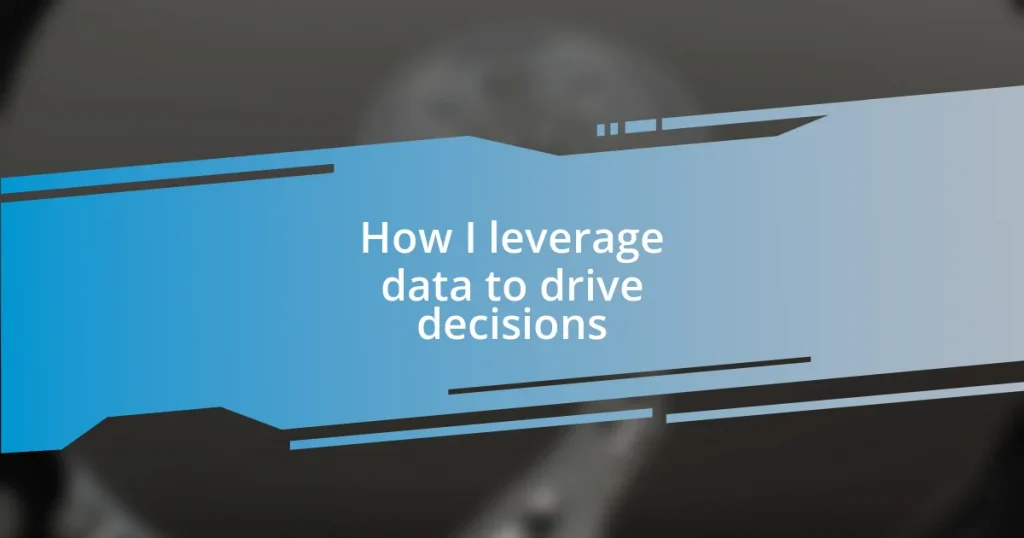Key takeaways:
- Embracing data enhances decision-making, often revealing trends that challenge initial assumptions and biases.
- Effective data collection requires clear objectives and strategic methods, focusing on relevant metrics to inform decisions.
- Post-decision analysis is vital for continuous improvement, as it helps understand successes and failures, driving future strategic adjustments.

Understanding data-driven decisions
Understanding data-driven decisions involves recognizing that data is more than just numbers; it tells a story. There was a time when I hesitated to trust data over my intuition. However, once I embraced it, I saw how much clearer my decision-making became, often revealing surprising trends I hadn’t considered.
You might wonder, why rely on data at all? I’ve learned that data offers a solid foundation for choices, often providing insights that align with our goals. For instance, using customer feedback data helped my team pivot our strategy effectively, seeing an uptick in engagement that we had always hoped for but couldn’t quite achieve before.
Data-driven decisions require a mindset shift. It’s about being open to what the data reveals, even when it challenges our biases. I recall a project where the data indicated a shift in customer preferences that contradicted my assumptions. Accepting that data was a game-changer; it opened up new avenues for growth that I never would’ve explored otherwise. Have you ever experienced that moment when the data just clicks and suddenly everything makes sense? It’s powerful.

Collecting relevant data effectively
In my experience, collecting relevant data effectively starts with clarity about what you’re looking to achieve. The first step is defining your objectives; without clear goals, you might end up with data that doesn’t serve your needs. I recall diving into a project and realizing too late that I had gathered metrics centered around general traffic instead of focusing on engagement metrics that directly related to our goals. This misstep taught me to create a focused data collection plan from the outset.
Here are some strategies I’ve found helpful for collecting relevant data:
- Clearly define your goals and objectives.
- Choose the right tools for data collection, whether it’s surveys, analytics software, or CRM systems.
- Prioritize data sources; focus on what will yield the most relevant information.
- Pilot test your methods; collect feedback to refine your approach.
- Regularly review and adjust your data collection strategies based on outcomes.
When I think about the power of data, it’s about being strategic and intentional. Once, for a marketing campaign, we focused on not just collecting data but making a conscious effort to understand our audience’s preferences. This involved reaching out through targeted surveys and personal interactions, leading to insights that had a profound impact on our campaign’s success. The emotional payoff came when I realized that understanding our audience meant more than numbers; it was about forging deeper connections that drove results.

Analyzing data for insights
When analyzing data for insights, I often find it essential to pinpoint patterns that might not be immediately visible. For instance, during a recent product launch, I unearthed crucial data points indicating customer behavioral shifts throughout the campaign period. These findings highlighted the importance of timing; we were able to adapt our communication strategies based on peak engagement periods, fundamentally changing how we approached our marketing efforts.
I’ve learned that analyzing data also means asking the right questions. One memorable instance was when I organized a focus group to delve deeper into our survey results. As we dissected feedback together, it became clear that while many responded positively, a significant minority expressed dissatisfaction. This prompted us to pivot our strategy, addressing unique pain points that hadn’t previously been on my radar. It’s fascinating how collaborative discussions can bring forth insights that raw data alone may not convey.
Finally, visuals can transform how we understand data. I remember creating a dashboard that allowed my team to visually track performance metrics in real-time. Suddenly, trends became more apparent, and we could quickly react to changes. This experience taught me that data isn’t just about numbers; it’s about crafting a narrative that guides you toward informed decisions.
| Analysis Method | Description |
|---|---|
| Trend Identification | Recognizing patterns over time to inform strategy. |
| Collaborative Review | Working with others to uncover deeper insights beyond data alone. |
| Visual Representation | Using dashboards and charts to highlight key performance metrics. |

Utilizing tools for data analysis
Utilizing the right tools for data analysis can truly elevate your decision-making process. For me, software like Tableau has been a game-changer. I remember the first time I used it; the ability to visualize complex datasets instantly engaged my team and sparked conversations that transformed our approach. Suddenly, we weren’t just looking at data—we were seeing stories unfold that led us to actionable insights.
It’s also vital to keep an open mind about the tools at your disposal. While I lean heavily on quantitative data analysis, I’ve found qualitative tools, like sentiment analysis, invaluable. There was an instance when I integrated social media monitoring into our strategy. By examining user sentiments around our brand, I discovered unexpected sentiments that prompted us to adjust our messaging. How often do we rush to conclusions based solely on numbers and forget to include the human element?
Moreover, I’ve come to appreciate the collaborative aspect of using data analysis tools. Just last month, during a brainstorming session, we used a combination of Google Analytics and customer feedback software to pinpoint opportunities for improvement. The discussions that ensued were invigorating, revealing insights that none of us had seen alone. I often ask myself, how can we leverage our collective knowledge? The answer is clear: by utilizing data analysis tools that encourage collaboration, we open doors to innovation that serve our objectives beautifully.

Implementing data findings in strategy
Implementing data findings into strategy requires a thoughtful approach. I vividly recall a time when our team had amassed a wealth of data from customer interactions. After digging into these findings, we realized that our target demographic was shifting slightly younger, yet we hadn’t adjusted our messaging accordingly. This epiphany led us to revamp our entire campaign, shifting the tone and style to resonate more with a younger audience. It was a striking reminder of how essential it is to be open to change based on data.
In another instance, I had the opportunity to coordinate a quarterly review utilizing our research findings directly into strategy planning. We had collected extensive data on customer preferences and buying patterns. During the meeting, as we shared insights on what worked and what didn’t, it became clear that we were all excited about one particular finding: our audience craved more eco-friendly products. We felt energized to explore sustainable options not previously considered. That moment highlighted the power of data to not only guide decisions but also to ignite creativity and passion within the team.
One aspect I continuously emphasize is the need for iterative reviewing of strategy based on data. There was a project where we launched a new feature, and early user data suggested it wasn’t performing as expected. Instead of letting it linger, we convened to reassess our positioning and marketing approach. This nimbleness allowed us to pivot quickly, resulting in a 30% increase in engagement just a few weeks later. How often do we lock ourselves into a plan, ignoring the valuable insights that data provides? I believe it’s crucial to remain flexible and responsive, making data-driven changes that not only enhance our strategy but also adapt to the needs and desires of our audience.

Measuring the impact of decisions
Measuring the impact of decisions can sometimes feel like staring into a foggy mirror; clarity comes with time and the right tools. I recall a project where we implemented a new customer support system. Initially, I was skeptical about how effective it would be, but by tracking key performance indicators like response time and customer satisfaction rates, I began to see the transformation. The data revealed a 40% boost in satisfaction scores, which was exhilarating! It showed me that measuring outcomes helps us understand not just if our decisions were right, but also how to fine-tune them moving forward.
Another memorable experience occurred during a product launch. We laid out metrics to gauge its success, focusing on sales data and user feedback. Week by week, we analyzed how different channels performed—what worked and what didn’t. When we noticed a dip in engagement from one specific source, we took immediate action. I remember feeling that same rush of motivation as the team collaborated to adjust our strategy. It’s fascinating how swiftly adapting to the data can lead to significant results, wouldn’t you agree? By grounding our decisions in tangible measurements, we unlock insights that are often hidden beneath surface-level observations.
I’ve learned that post-decision analysis is just as crucial as the decisions themselves. There was a time when we launched a marketing campaign without fully assessing previous performance data. The results were underwhelming, which was disappointing at first. But instead of feeling defeated, we conducted a thorough review, identifying the missed opportunities, such as not capitalizing on a growing trend in video marketing. That setback taught me a powerful lesson: the real value lies in understanding why something worked—or didn’t. This ongoing learning encourages a culture where every outcome is a stepping stone toward improvement, and it’s a mindset I strongly advocate for in every meeting.
















